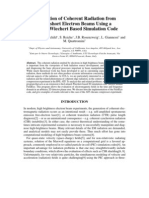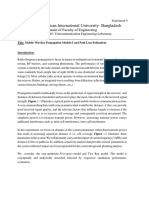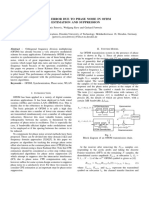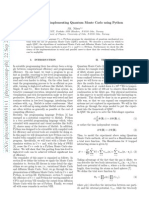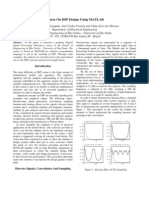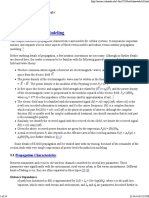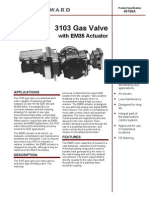Fourier and Spectral Applications
Fourier and Spectral Applications
Uploaded by
Vinay GuptaCopyright:
Available Formats
Fourier and Spectral Applications
Fourier and Spectral Applications
Uploaded by
Vinay GuptaOriginal Title
Copyright
Available Formats
Share this document
Did you find this document useful?
Is this content inappropriate?
Copyright:
Available Formats
Fourier and Spectral Applications
Fourier and Spectral Applications
Uploaded by
Vinay GuptaCopyright:
Available Formats
Sample page from NUMERICAL RECIPES IN C: THE ART OF SCIENTIFIC COMPUTING (ISBN 0-521-43108-5) Copyright (C) 1988-1992 by Cambridge
University Press. Programs Copyright (C) 1988-1992 by Numerical Recipes Software. Permission is granted for internet users to make one paper copy for their own personal use. Further reproduction, or any copying of machinereadable files (including this one) to any server computer, is strictly prohibited. To order Numerical Recipes books or CDROMs, visit website http://www.nr.com or call 1-800-872-7423 (North America only), or send email to directcustserv@cambridge.org (outside North America).
Chapter 13. Fourier and Spectral Applications
13.0 Introduction
Fourier methods have revolutionized elds of science and engineering, from radio astronomy to medical imaging, from seismology to spectroscopy. In this chapter, we present some of the basic applications of Fourier and spectral methods that have made these revolutions possible. Say the word Fourier to a numericist, and the response, as if by Pavlovian conditioning, will likely be FFT. Indeed, the wide application of Fourier methods must be credited principally to the existence of the fast Fourier transform. Better mousetraps stand aside: If you speed up any nontrivial algorithm by a factor of a million or so, the world will beat a path towards nding useful applications for it. The most direct applications of the FFT are to the convolution or deconvolution of data (13.1), correlation and autocorrelation (13.2), optimal ltering (13.3), power spectrum estimation (13.4), and the computation of Fourier integrals (13.9). As important as they are, however, FFT methods are not the be-all and end-all of spectral analysis. Section 13.5 is a brief introduction to the eld of time-domain digital lters. In the spectral domain, one limitation of the FFT is that it always represents a functions Fourier transform as a polynomial in z = exp(2if ) (cf. equation 12.1.7). Sometimes, processes have spectra whose shapes are not well represented by this form. An alternative form, which allows the spectrum to have poles in z , is used in the techniques of linear prediction (13.6) and maximum entropy spectral estimation (13.7). Another signicant limitation of all FFT methods is that they require the input data to be sampled at evenly spaced intervals. For irregularly or incompletely sampled data, other (albeit slower) methods are available, as discussed in 13.8. So-called wavelet methods inhabit a representation of function space that is neither in the temporal, nor in the spectral, domain, but rather something in-between. Section 13.10 is an introduction to this subject. Finally 13.11 is an excursion into numerical use of the Fourier sampling theorem.
537
538
Chapter 13.
Fourier and Spectral Applications
13.1 Convolution and Deconvolution Using the FFT
We have dened the convolution of two functions for the continuous case in equation (12.0.8), and have given the convolution theorem as equation (12.0.9). The theorem says that the Fourier transform of the convolution of two functions is equal to the product of their individual Fourier transforms. Now, we want to deal with the discrete case. We will mention rst the context in which convolution is a useful procedure, and then discuss how to compute it efciently using the FFT. The convolution of two functions r(t) and s(t), denoted r s, is mathematically equal to their convolution in the opposite order, s r. Nevertheless, in most applications the two functions have quite different meanings and characters. One of the functions, say s, is typically a signal or data stream, which goes on indenitely in time (or in whatever the appropriate independent variable may be). The other function r is a response function, typically a peaked function that falls to zero in both directions from its maximum. The effect of convolution is to smear the signal s(t) in time according to the recipe provided by the response function r(t), as shown in Figure 13.1.1. In particular, a spike or delta-function of unit area in s which occurs at some time t0 is supposed to be smeared into the shape of the response function itself, but translated from time 0 to time t 0 as r(t t0 ). In the discrete case, the signal s(t) is represented by its sampled values at equal time intervals sj . The response function is also a discrete set of numbers r k , with the following interpretation: r 0 tells what multiple of the input signal in one channel (one particular value of j ) is copied into the identical output channel (same value of j ); r1 tells what multiple of input signal in channel j is additionally copied into output channel j + 1; r1 tells the multiple that is copied into channel j 1; and so on for both positive and negative values of k in r k . Figure 13.1.2 illustrates the situation. Example: a response function with r 0 = 1 and all other rk s equal to zero is just the identity lter: convolution of a signal with this response function gives identically the signal. Another example is the response function with r 14 = 1.5 and all other rk s equal to zero. This produces convolved output that is the input signal multiplied by 1.5 and delayed by 14 sample intervals. Evidently, we have just described in words the following denition of discrete convolution with a response function of nite duration M :
M/2
Sample page from NUMERICAL RECIPES IN C: THE ART OF SCIENTIFIC COMPUTING (ISBN 0-521-43108-5) Copyright (C) 1988-1992 by Cambridge University Press. Programs Copyright (C) 1988-1992 by Numerical Recipes Software. Permission is granted for internet users to make one paper copy for their own personal use. Further reproduction, or any copying of machinereadable files (including this one) to any server computer, is strictly prohibited. To order Numerical Recipes books or CDROMs, visit website http://www.nr.com or call 1-800-872-7423 (North America only), or send email to directcustserv@cambridge.org (outside North America).
(r s)j
k=M/2+1
sj k rk
(13.1.1)
If a discrete response function is nonzero only in some range M/2 < k M/2, where M is a sufciently large even integer, then the response function is called a nite impulse response (FIR), and its duration is M . (Notice that we are dening M as the number of nonzero values of r k ; these values span a time interval of M 1 sampling times.) In most practical circumstances the case of nite M is the case of interest, either because the response really has a nite duration, or because we choose to truncate it at some point and approximate it by a nite-duration response function. The discrete convolution theorem is this: If a signal s j is periodic with period N , so that it is completely determined by the N values s 0 , . . . , sN 1 , then its
You might also like
- 1975 Number Theoretic Transforms To Implement Fast Digital ConvolutionDocument11 pages1975 Number Theoretic Transforms To Implement Fast Digital ConvolutionRajesh BathijaNo ratings yet
- Laboratory Report Coverpage (Co4 - Po9)Document24 pagesLaboratory Report Coverpage (Co4 - Po9)Ainie AzizahNo ratings yet
- Optimal Approximation of Analog PID Controllers of Complex Fractional-OrderDocument28 pagesOptimal Approximation of Analog PID Controllers of Complex Fractional-OrderGabriel CelestinoNo ratings yet
- Average Fade CorrelationDocument5 pagesAverage Fade Correlationابراهيم السعيديNo ratings yet
- Decode-and-Forward Cooperative Communications: Performance Analysis With Power Constraints in The Presence of Timing ErrorsDocument13 pagesDecode-and-Forward Cooperative Communications: Performance Analysis With Power Constraints in The Presence of Timing ErrorsamanofgodNo ratings yet
- Z-Plane Synthesis of Response Functions and Interpolators in Z-Transformelectromagnetic Transient Analysis in Power SystemsDocument7 pagesZ-Plane Synthesis of Response Functions and Interpolators in Z-Transformelectromagnetic Transient Analysis in Power SystemsranaateeqNo ratings yet
- DSP and Power System ProtectionDocument11 pagesDSP and Power System ProtectionsegamegaNo ratings yet
- Performance Analysis of MIMO-OFDM Systems On Nakagami-M Fading ChannelsDocument5 pagesPerformance Analysis of MIMO-OFDM Systems On Nakagami-M Fading ChannelsmnoppNo ratings yet
- Improved Separation of Electrocardiography Signals and Mixed MR Images by Using Finite Ridgelet TransformDocument8 pagesImproved Separation of Electrocardiography Signals and Mixed MR Images by Using Finite Ridgelet TransformInternational Journal of Application or Innovation in Engineering & ManagementNo ratings yet
- Wavelet Transform Approach To Distance: Protection of Transmission LinesDocument6 pagesWavelet Transform Approach To Distance: Protection of Transmission LinesthavaselvanNo ratings yet
- UBICC Eltholth WHT 82Document5 pagesUBICC Eltholth WHT 82Ubiquitous Computing and Communication JournalNo ratings yet
- Mimo Generalized Decorrelating Discrete-Time Rake Receiver: Tunc Er Baykas, Mohamed Siala, Abbas Yongac o GluDocument4 pagesMimo Generalized Decorrelating Discrete-Time Rake Receiver: Tunc Er Baykas, Mohamed Siala, Abbas Yongac o Glubavar88No ratings yet
- Carrier Frequency Synchronization in The Downlink of 3Gpp LteDocument6 pagesCarrier Frequency Synchronization in The Downlink of 3Gpp LteAshok KumarNo ratings yet
- Itt - (J+L) TI.v (T-JT) J: (Half Short-Circuits) .) )Document8 pagesItt - (J+L) TI.v (T-JT) J: (Half Short-Circuits) .) )Luisa De CairesNo ratings yet
- Common Phase DUE To Phase Noise in Ofdm Estimation and SuppressionDocument5 pagesCommon Phase DUE To Phase Noise in Ofdm Estimation and SuppressionBrudedo FuystolNo ratings yet
- Performance Analysis of Decode-and-Forward Relay Network Under Adaptive M-QAMDocument5 pagesPerformance Analysis of Decode-and-Forward Relay Network Under Adaptive M-QAMballmerNo ratings yet
- Eqe 4290120405Document17 pagesEqe 4290120405as3002686No ratings yet
- Calculation of Coherent Radiation From Ultra-Short Electron Beams Using A Liénard-Wiechert Based Simulation CodeDocument7 pagesCalculation of Coherent Radiation From Ultra-Short Electron Beams Using A Liénard-Wiechert Based Simulation CodeMichael Fairchild100% (2)
- Wcnc07 CfoDocument5 pagesWcnc07 CfowoodksdNo ratings yet
- Analysis Simulation of Ds-Cdma Mobile System in Non-Linear, Frequency Selective Slow ChannelDocument5 pagesAnalysis Simulation of Ds-Cdma Mobile System in Non-Linear, Frequency Selective Slow ChannelAnonymous JPbUTto8tqNo ratings yet
- Capacity Evaluation of Cellular CDMA: Q Ang WangDocument8 pagesCapacity Evaluation of Cellular CDMA: Q Ang Wanggzb012No ratings yet
- FFT For ExperimentalistsDocument24 pagesFFT For ExperimentalistsMara FelipeNo ratings yet
- Expt-4 Lab Manual TE LabDocument8 pagesExpt-4 Lab Manual TE LabRuham RofiqueNo ratings yet
- Rise Time and BandwidthDocument9 pagesRise Time and BandwidthVijayaraghavan VNo ratings yet
- Frequency Diverse MIMO Techniques For RadarDocument22 pagesFrequency Diverse MIMO Techniques For RadarNamith DevadigaNo ratings yet
- Novel Study On Paprs Reduction in Wavelet-Based Multicarrier Modulation SystemsDocument8 pagesNovel Study On Paprs Reduction in Wavelet-Based Multicarrier Modulation Systemsbavar88No ratings yet
- MunjaDocument6 pagesMunjaBat MojNo ratings yet
- Common Phase Error Due To Phase Noise in Ofdm - Estimation and SuppressionDocument5 pagesCommon Phase Error Due To Phase Noise in Ofdm - Estimation and SuppressionemadhusNo ratings yet
- Brinker 2001Document5 pagesBrinker 2001Francisco CalderónNo ratings yet
- Direct Frequency Domain Computation of Transmission Line Transients Due To Switching OperationsDocument7 pagesDirect Frequency Domain Computation of Transmission Line Transients Due To Switching OperationsdanluscribNo ratings yet
- Implementing Wimax Ofdm Timing and Frequency Offset Estimation in Lattice FpgasDocument21 pagesImplementing Wimax Ofdm Timing and Frequency Offset Estimation in Lattice FpgasvandalashahNo ratings yet
- Reducing Front-End Bandwidth May Improve Digital GNSS Receiver PerformanceDocument6 pagesReducing Front-End Bandwidth May Improve Digital GNSS Receiver Performanceyaro82No ratings yet
- Numerical - Recipes 664 671Document8 pagesNumerical - Recipes 664 671lynettelmx111No ratings yet
- Montepython: Implementing Quantum Monte Carlo Using PythonDocument17 pagesMontepython: Implementing Quantum Monte Carlo Using PythonJuan Bernardo Delgadillo GallardoNo ratings yet
- Signal Processing: Darian M. Onchis, Pavel RajmicDocument6 pagesSignal Processing: Darian M. Onchis, Pavel RajmicAmir JoonNo ratings yet
- Performance Analysis of Power Line Communication Using DS-CDMA Technique With Adaptive Laguerre FiltersDocument5 pagesPerformance Analysis of Power Line Communication Using DS-CDMA Technique With Adaptive Laguerre FiltersMasterArvinNo ratings yet
- 1043Document6 pages1043Eng-Sa'di Y. TamimiNo ratings yet
- Low-Latency Convolution For Real-Time ApplicationDocument7 pagesLow-Latency Convolution For Real-Time ApplicationotringalNo ratings yet
- Estimating The Number of Modes in Multimode Waveguide Propagation EnvironmentDocument4 pagesEstimating The Number of Modes in Multimode Waveguide Propagation EnvironmentyomatotyNo ratings yet
- P I P R L D S e F: Apr TeDocument11 pagesP I P R L D S e F: Apr Teዜና ማርቆስNo ratings yet
- UBICC - Samira - 94 - 608 - 608Document8 pagesUBICC - Samira - 94 - 608 - 608Ubiquitous Computing and Communication JournalNo ratings yet
- Radio Propagation ModelingDocument24 pagesRadio Propagation Modelingcoolboy_usamaNo ratings yet
- (1967) Digital Pulse Compression Radar ReceiverDocument9 pages(1967) Digital Pulse Compression Radar ReceiverAlex YangNo ratings yet
- Convolutional Coded On-Off Keying Free-Space Optical Links Over Fading ChannelsDocument6 pagesConvolutional Coded On-Off Keying Free-Space Optical Links Over Fading ChannelsseventhsensegroupNo ratings yet
- Spectral Efficiency Analysis in OFDM and OFDM/OQAM Based Cognitive Radio NetworksDocument5 pagesSpectral Efficiency Analysis in OFDM and OFDM/OQAM Based Cognitive Radio NetworksTrần Mạnh HùngNo ratings yet
- Pico Second Labs PDFDocument5 pagesPico Second Labs PDFVenkatesh KarriNo ratings yet
- Optimizatsiya Vnutrennih Poter V Elementah Konstruktsii Osnovannaya Na Statisticheskom Energeticheskom Metode Rascheta Vibratsii IDocument11 pagesOptimizatsiya Vnutrennih Poter V Elementah Konstruktsii Osnovannaya Na Statisticheskom Energeticheskom Metode Rascheta Vibratsii IKirill PerovNo ratings yet
- Franklin Note 2Document21 pagesFranklin Note 2WylieNo ratings yet
- Application of Wave-Number Approach For Room Behaviour Analysis and Absorption Coefficient MeasurementDocument9 pagesApplication of Wave-Number Approach For Room Behaviour Analysis and Absorption Coefficient MeasurementAugustoNo ratings yet
- VHF Radar Target Detection in The Presence of Clutter: Boriana VassilevaDocument8 pagesVHF Radar Target Detection in The Presence of Clutter: Boriana VassilevaGhada HamzaNo ratings yet
- Removal of DCDocument7 pagesRemoval of DCsirisiri100No ratings yet
- On Erlang Capacity C D M A Cellular: The SystemsDocument7 pagesOn Erlang Capacity C D M A Cellular: The SystemsazizbahmaniNo ratings yet
- J30 DAC Transisiton Distortion, Jitter, Slew RateDocument17 pagesJ30 DAC Transisiton Distortion, Jitter, Slew RateАлексей ГрабкоNo ratings yet
- Accurate Analysis of On-Chip Inductance Effects and Implications For OptimalDocument4 pagesAccurate Analysis of On-Chip Inductance Effects and Implications For Optimalzhouweihit123No ratings yet
- Journal 11Document6 pagesJournal 11Eccker RekcceNo ratings yet
- Mimo Radar Detection in CompoundDocument9 pagesMimo Radar Detection in CompoundIJMAJournalNo ratings yet
- Anais - SBRT - 2017 (PDF - Io)Document5 pagesAnais - SBRT - 2017 (PDF - Io)antonio peixotoNo ratings yet
- Spline and Spline Wavelet Methods with Applications to Signal and Image Processing: Volume III: Selected TopicsFrom EverandSpline and Spline Wavelet Methods with Applications to Signal and Image Processing: Volume III: Selected TopicsNo ratings yet
- Understanding Vector Calculus: Practical Development and Solved ProblemsFrom EverandUnderstanding Vector Calculus: Practical Development and Solved ProblemsNo ratings yet
- Fraction Animal ClassDocument3 pagesFraction Animal ClassVinay GuptaNo ratings yet
- A Mass-Conserving Level-Set Method For Modelling of Multi-Phase OwsDocument23 pagesA Mass-Conserving Level-Set Method For Modelling of Multi-Phase OwsVinay GuptaNo ratings yet
- 13 - Fluids at Rest and Piped FluidsDocument7 pages13 - Fluids at Rest and Piped FluidsVinay GuptaNo ratings yet
- Lam MasterTechWiskDocument55 pagesLam MasterTechWiskVinay GuptaNo ratings yet
- Seepage and Thermal Effects in Porous MediaDocument6 pagesSeepage and Thermal Effects in Porous MediaVinay GuptaNo ratings yet
- Morgan Nathaniel R 200505 PHDDocument104 pagesMorgan Nathaniel R 200505 PHDVinay GuptaNo ratings yet
- 6.4 Geothermal Convection in Porous MediaDocument2 pages6.4 Geothermal Convection in Porous MediaVinay GuptaNo ratings yet
- Water in The Atmosphere: ATS 351 - Lecture 5Document33 pagesWater in The Atmosphere: ATS 351 - Lecture 5Vinay Gupta100% (1)
- Test-Case Number 13: Shock Tubes (PA)Document10 pagesTest-Case Number 13: Shock Tubes (PA)Vinay GuptaNo ratings yet
- Solving Time Dependent ProblemsDocument30 pagesSolving Time Dependent ProblemsVinay GuptaNo ratings yet
- ITK-233-2 - PVT Behavior of FluidDocument57 pagesITK-233-2 - PVT Behavior of FluidVinay GuptaNo ratings yet
- Aw of OiseuilleDocument4 pagesAw of OiseuilleVinay GuptaNo ratings yet
- Pressure Outlet Ghost Fluid TreatmentDocument18 pagesPressure Outlet Ghost Fluid TreatmentVinay GuptaNo ratings yet
- A Fully Conservative Ghost Fluid Method & Stiff Detonation WavesDocument10 pagesA Fully Conservative Ghost Fluid Method & Stiff Detonation WavesVinay GuptaNo ratings yet
- Input and Output 2. Modules: Sample Programs - Week 4 AUTUMN 2004Document5 pagesInput and Output 2. Modules: Sample Programs - Week 4 AUTUMN 2004Vinay GuptaNo ratings yet
- Turbulence AUTUMN 2004Document20 pagesTurbulence AUTUMN 2004Vinay GuptaNo ratings yet
- 210F - Ttc-Pil-1, TTD-1Document1 page210F - Ttc-Pil-1, TTD-1Tovar ArmandoNo ratings yet
- Appendix C5 - Stakeholder CorrespondenceDocument28 pagesAppendix C5 - Stakeholder Correspondenceinstallment paymentNo ratings yet
- Air Blast Circuit Breaker 1Document19 pagesAir Blast Circuit Breaker 1Bidya Bhusan MajiNo ratings yet
- 1 DistressDocument2 pages1 DistressAlin PieNo ratings yet
- VLSI QuestionsDocument1 pageVLSI QuestionsHemant SaraswatNo ratings yet
- SMPS ComponentsDocument2 pagesSMPS Componentsaloksxn.careerNo ratings yet
- Sop Manoj NYITDocument2 pagesSop Manoj NYITsanNo ratings yet
- LVDSDocument35 pagesLVDSRinaldy100% (1)
- Stratos-Micra 100 Data SHT PDFDocument2 pagesStratos-Micra 100 Data SHT PDFColesha BarukaNo ratings yet
- COEX™ C3000 HD LE IP PTZ Camera StationDocument4 pagesCOEX™ C3000 HD LE IP PTZ Camera StationTrisun ReyNo ratings yet
- MT1769 Full DocumentationDocument25 pagesMT1769 Full Documentationrain.kam86No ratings yet
- Product Specification: Model NO.: 7.5inch E-Paper BDocument39 pagesProduct Specification: Model NO.: 7.5inch E-Paper BfirsttenorNo ratings yet
- ESSAILEC®+range +CATALOGUE+2011Document24 pagesESSAILEC®+range +CATALOGUE+2011cesar_augusto_1965No ratings yet
- MagneticShapes Puzzles ButterflyFieldsDocument82 pagesMagneticShapes Puzzles ButterflyFieldskrishnakant gargNo ratings yet
- Training Report ON "Central Electronics Limited"Document22 pagesTraining Report ON "Central Electronics Limited"nirveshdagarNo ratings yet
- 3103 Gas Valve EM35 DriverDocument4 pages3103 Gas Valve EM35 Driverchris_skyanNo ratings yet
- Application Data Sheet On Line Electrode Impedance Measurement Rosemount en 70778Document3 pagesApplication Data Sheet On Line Electrode Impedance Measurement Rosemount en 70778Yesid DiazNo ratings yet
- Wave Properties of LightDocument38 pagesWave Properties of LightMary Angelica Dela PazNo ratings yet
- BTS Fault AlarmDocument10 pagesBTS Fault AlarmVíctor IdiaqzNo ratings yet
- 860 CD 00151378Document31 pages860 CD 00151378Юрий ВетровNo ratings yet
- Easy UPS 3S - E3SUPS40KHDocument3 pagesEasy UPS 3S - E3SUPS40KHLokendraNo ratings yet
- 17.password Based Security Door Lock SystemDocument3 pages17.password Based Security Door Lock SystemBhagya AlleNo ratings yet
- Following Objectives Are Treated in The DIGSI Advanced TrainingDocument13 pagesFollowing Objectives Are Treated in The DIGSI Advanced TrainingProteccion MedicionNo ratings yet
- CRM 100BDocument2 pagesCRM 100BPUNNAPRA SubstationNo ratings yet
- CET Modular UPS Datasheet Flexa Subrack System en v1.3Document2 pagesCET Modular UPS Datasheet Flexa Subrack System en v1.3dfghjkNo ratings yet
- Capacitance Estimation Method of Bulk Capacitors For BLDCDocument9 pagesCapacitance Estimation Method of Bulk Capacitors For BLDCdot11No ratings yet
- CAMP - Fabrication of Simple Piezoelectric Generators To Power LEDDocument3 pagesCAMP - Fabrication of Simple Piezoelectric Generators To Power LEDcgtnss4No ratings yet
- Model TA Belt Alignment ControlDocument4 pagesModel TA Belt Alignment ControlRobertoNo ratings yet
- Dynamics of Electrical MachinesDocument3 pagesDynamics of Electrical Machinesashwinigondane0594No ratings yet

















